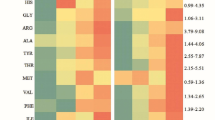Abstract
We studied the effect of extractive substances (ES) and total glycoside fraction (TGF) from Panax ginseng on plant cell growth. The seeds of cucumber Cucumis sativus L., KIT variety, were used for the biological assay. The tested substances inhibited the primary root growth in Cucumis sativus seedlings. Actively growing seedlings were most sensitive to this effect.
Similar content being viewed by others
REFERENCES
Anisimov, M.M., Stekhova, S.I., and Pokhilo, N.D., Effect of Betulafolientetraol on Root Growth of Cucumis sativus L. Seedlings, Rast. Resursy, 1998, vol. 3, pp. 103–106.
Anisimov, M.M., Petrova, O.M., Logachev, V.V., Donets, E.A., and Gorovoi, P.G., Effect of Water-Ethanol Extract of Far-Eastern Relict Plant Caulophyllum robustum Maxim. on Root Growth of Cucumis sativus L. Seedlings, Rast. Resursy, 2000, vol. 4, pp. 100–104.
Boiteau, P., Pasich, B., and Ratismanga, A.R., The Triterpenoida in Plant and Animal Physiology, Paris: Gauthier-Villars, 1964.
Fuzzati, N., Gabetta, B., Jayakar, K., Pace, R., and Peterlongo, F., Liquid Chromatography-Electrospray Mass Spectrometric Identification of Ginsenosides in Panax ginseng Roots, J. Chromatogr., 1999, vol. 854, pp. 69–79.
Grossmann, K., Mode of Action of Auxin Herbicides: A New Ending to a Long, Drawn out Story, Trends Plant Sci., 2000, vol. 5, no.12, pp. 506–508.
Gumnicka, O. and Oleszek, W., Triterpene Saponins from the Aerial Parts of Dianthus caryophyllus Var. Remontant Hort., Acta Soc. Bot. Pol., 1998, vol. 67, pp. 65–68.
Hiradate, S., Yada, H., Ishii, T., Nakajima, N., Ohnishi-Kameyama, M., Sugie, H., Zungsontiport, S., and Fujii, Y., Three Plant Growth Inhibiting Saponins from Duranta repens, Phytochem., 1999, vol. 52, pp. 1223–1228.
Huong, N.T.T., Matsumoto, K., Kasai, R., Yamasaki, K., and Watanabe, H., In vitro Antioxidant Activity of Vietnamese Ginseng Saponin and Its Components Biol. Pharmacol. Bull., 1998, vol. 21, pp. 978–981.
Lehman, M.E. and Blum, U., Influence of Pretreatment Stresses on Inhibitory Effects of Ferulic Acid, an Allelopathic Phenolic Acid, J. Chem. Ecol., 1999, vol. 25, pp. 1517–1529.
Li, J.P., Huang, M., Teoh, H., and Man, R.Y.K., Interactions between Panax quinquefolium Saponins and Vitamin C Are Observed in Vitro, Mol. Cell. Biochem., 2000, vol. 204, pp. 77–82.
Mishustin, E.N. and Naumova, A.N., Excretion of Toxic Substances by Alfalfa and Their Influence on Cotton and Soil Microflora, Izv. Akad. Nauk SSSR, Ser. Biol., 1955, no. 6, pp. 3–9.
Monteuuis, O. and Bon, M.-C., Influence of Auxins and Darkness on in vitro Rooting of Micropropagated Shoots from Mature and Juvenile Acacia mangium, Plant Cell Tissue Organ Cult., 2000, vol. 63, pp. 173–177.
Nord, E.C. and Atta van, G.R., Saponin a Seed Germination Inhibitor, Forest. Sci., 1960, vol. 6, pp. 350–353.
Shibata, S., Recent Studies on Biologically Active Constituents of Medicinal Plants-Biologically Active Saponine and Sapogenine and their Chemical Modifications, Third Int. Conf. on Chemistry and Biotechnology of Biologically Active Natural Products, Sofia, 1985, vol. 1, pp. 148–167.
Stekhova, S.I., Anisimov, M.M., Atopkina, L.N., and Uvarova, N.I., Structural and Functional Properties of Panax ginseng C.A. Meyer Panaxasides and Their Analogs: 5. Influence of 20(S)-Protopanaxadiol and Its Glycosides on the Root Growth of Cucumis sativus L. Seedlings, Rast. Resursy, 2001, vol. 1, pp. 82–88.
Tsurumi, S., Ishizava, K., Rahman, A., Soga, K., Hoson, T., Goto, N., and Kamisaka, S., Effects of Chromosaponin I and Brassinolide on the Growth of Roots in Etiolated Arabidopsis Seedlings, Plant. Physiol., 2000, vol. 156, pp. 60–67.
Waller, G.R. and Einhellig, F.A., Overview of Allelopathy in Agriculture, Forestry, and Ecology, Biodiversity and Allelopathy: From Organisms to Ecosystems in the Pacific, Chou, C.-H., Waller, G.R., and Reinhardt, C., Eds., Acad. Sinica, 1999, pp. 221–261.
Uvarova, N.I., Makhan'kov, V.V., Malinovskaya, G.V., Samoshina, N.F., Atopkina, L.N., Likhatskaya, G.N., Kim, N.Yu., Anisimov, M.M., and Elyakov, G.B., Chemical Properties, Comparative Analysis, and Biological Activity of Triterpene Glycosides from Wild and Planted Ginseng Panax ginseng C.A. Meyer of Far East Origin, Khim. Farm. Zh., 2000, vol. 34, no.3, pp. 19–25.
Yi, H.C., Joo, S., Nam, K.H., Lee, J.S., Kang, B.G., and Kim, W.T., Auxin and Brassinosteroid Differentially Regulate the Expression of Three Members of the 1-Aminocyclopropane-1-Carboxylate Synthase Gene Family in Mung Bean Vigna radiata L., Plant. Mol. Biol., 1999, vol. 41, pp. 443–454.
Author information
Authors and Affiliations
Rights and permissions
About this article
Cite this article
Anisimov, M.M., Logachev, V.V., Likhatskaya, G.N. et al. Effect of Extractive Substances and Total Glycoside Fraction from Panax ginseng C. A. Meyer on Root Growth of Cucumis sativus L. Seedlings. Biology Bulletin 30, 287–290 (2003). https://doi.org/10.1023/A:1023868014868
Issue Date:
DOI: https://doi.org/10.1023/A:1023868014868




